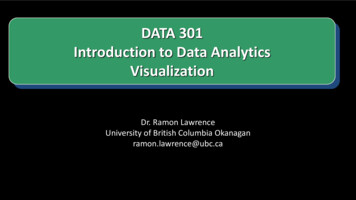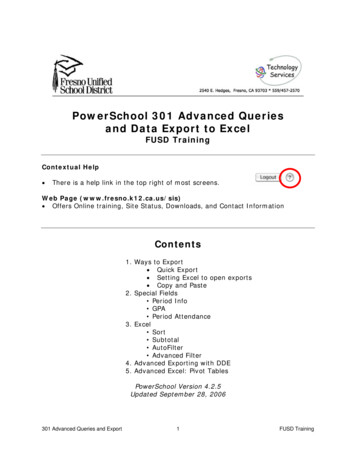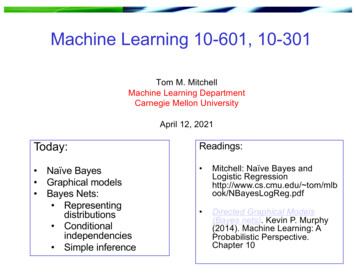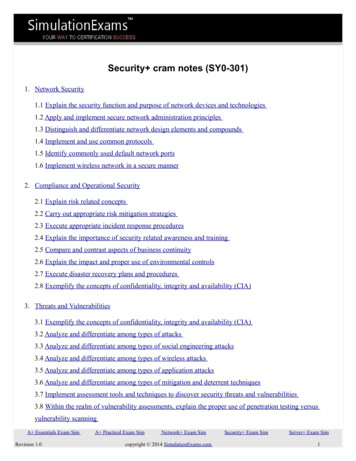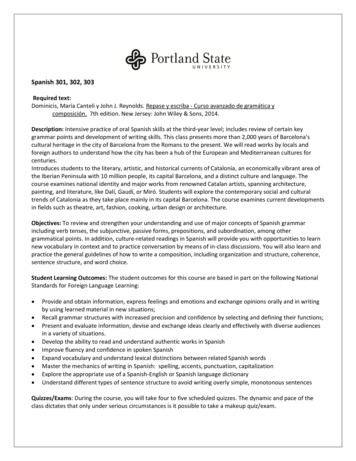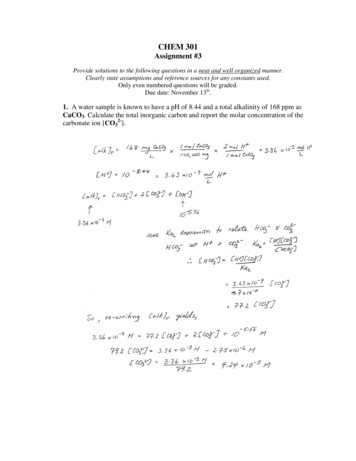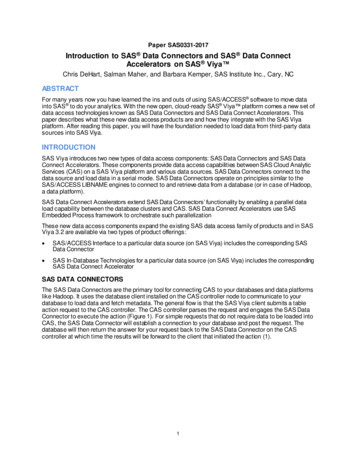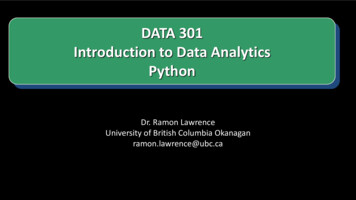
Transcription
DATA 301Introduction to Data AnalyticsPythonDr. Ramon LawrenceUniversity of British Columbia Okanaganramon.lawrence@ubc.ca
DATA 301: Data Analytics (2)Why learn Python?Python is increasingly the most popular choice of programminglanguage for data analysts because it is designed to be simple,efficient, and easy to read and write.There are many open source software and libraries that use Pythonand data analysis tools built on them.We will use Python to learn programming and explore fundamentalprogramming concepts of commands, variables, decisions, repetition,and events.
DATA 301: Data Analytics (3)What is Python?Python is a general, high-level programming language designed forcode readability and simplicity.Python is available for free as open source and has a large communitysupporting its development and associated tools.Python was developed by Guido van Rossum and first released in1991. Python 2.0 was released in 2000 (latest version 2.7), and abackwards-incompatible release Python 3 was in 2008. Our coding style will be Python 3 but most code will also work for Python 2. Name does refer to Monty Python.
DATA 301: Data Analytics (4)Python Language CharacteristicsPython supports: dynamic typing – types can change at run-timemulti-paradigm – supports procedural, object-oriented, functional stylesauto-memory management and garbage collectionextendable – small core language that is easily extendablePython core philosophies (by Tim Peters: https://www.python.org/dev/peps/pep-0020/) Beautiful is better than uglyExplicit is better than implicitSimple is better than complexComplex is better than complicatedReadability counts
DATA 301: Data Analytics (5)Some Quotes"If you can't write it down in English, you can't code it."-- Peter Halpern"If you lie to the computer, it will get you."-- Peter Farrar
DATA 301: Data Analytics (6)Introduction to ProgrammingAn algorithm is a precise sequence of steps to produce a result. Aprogram is an encoding of an algorithm in a language to solve aparticular problem.There are numerous languages that programmers can use to specifyinstructions. Each language has its different features, benefits, andusefulness.The goal is to understand fundamental programming concepts thatapply to all languages.
DATA 301: Data Analytics (7)Python: Basic RulesTo program in Python you must follow a set of rules for specifying yourcommands. This set of rules is called a syntax. Just like any other language, there are rules that you must follow if you are tocommunicate correctly and precisely.Important general rules of Python syntax: Python is case-sensitive.Python is particular on whitespace and indentation.The end of command is the end of line. There is no terminator like a semi-colon.Use four spaces for indentation whenever in a block.def spam():eggs 12return eggsprint spam()
DATA 301: Data Analytics (8)CommentsComments are used by the programmer to document and explain thecode. Comments are ignored by the computer. Two types: 1) One line comment: put “#” before the comment and any characters to the endof line are ignored by the computer. 2) Multiple line comment: put “"""” at the start of the comment and “"""” atthe end of the comment. The computer ignores everything between the startand end comment indicators.Example:# Single line commentprint (1) # Comment at end of line""" This is amultiple linecomment """
DATA 301: Data Analytics (9)Python ProgrammingA Python program, like a book, is read left to right and top to bottom.Each command is on its own line.# Sample Python programname "Joe"print("Hello")print("Name: " name)Flow of ExecutionStart at first statement attop and proceed downexecuting each statementA user types in a Python program in a text editor or developmentenvironment and then runs the program.
DATA 301: Data Analytics (10)Python Editor - jupyterjupyter is a graphical, browser-based editor for Python.To create a new notebook, select File, New Notebook, Python3.
DATA 301: Data Analytics (11)Python Editor – jupyter notebookButton to run code (shortcut is Ctrl Enter)Python codeProgram output
DATA 301: Data Analytics (12)Python: Hello World!Simplest program:print("Hello World!")The print function will print to the terminal (standard output)whatever data (number, string, variable) it is given.
DATA 301: Data Analytics (13)Try it: Python PrintingQuestion 1: Write a Python program that prints "I am fantastic!".Question 2: Write a Python program that prints these three lines:I know that I can program in Python.I am programming right now.My awesome program has three lines!
DATA 301: Data Analytics (14)Python QuestionQuestion: How many of the following statements are TRUE?1) Python is case-sensitive.2) A command in Python is terminated by a semi-colon.3) Indentation does not matter in Python.4) A single line comment starts with """.5) The print command prints to standard input.A) 0B) 1C) 2D) 3E) 4
DATA 301: Data Analytics (15)VariablesA variable is a name that refers to a location that stores a data value.Location Age18Value (cute )IMPORTANT: The value at a location can change using initialization orassignment.
DATA 301: Data Analytics (16)Variable AssignmentAssignment using an sets the value of a variable.Example:num 10message "Hello world!"num10messageHello world!
DATA 301: Data Analytics (17)Python VariablesTo create a variable in Python, you must only provide a name. A variable type is dynamic. It can store numbers, strings, or Boolean at any time.Example:val 5val "Hello"Boolean values can be either True or False. Note case matters.isAwesome TrueisAwesome False
DATA 301: Data Analytics (18)Variable RulesVariables are a name that must begin with a letter and cannot containspaces.Variables are created when they are first used. There is no specialsyntax to declare (create) a variable.Variable names ARE case-sensitive. Numbers are allowed (but not atthe start). Only other symbol allowed is underscore (' ');A programmer picks the names for variables, but try to make thenames meaningful and explain their purpose.Avoid naming variables as reserved words. A reserved word hasspecial meaning in the language. e.g. if, for, else
DATA 301: Data Analytics (19)Python Variables QuestionQuestion: How many of the following variable names are valid?1) name2) string23) 2cool4) under score5) spaces name6) elseA) 0B) 1C) 2D) 3E) 4
DATA 301: Data Analytics (20)Python Math ExpressionsMath expressions in Python:OperationSyntaxExampleAdd 5 3Subtract-10 – 2Multiply*5*3Divide/9/4Modulus%9%4(answer is 1)Exponent**5 ** 2(answer is 25)
DATA 301: Data Analytics (21)Expressions - Operator PrecedenceEach operator has its own priority similar to their priority in regularmath expressions: 1) Any expression in parentheses is evaluated first starting with the inner mostnesting of parentheses. 2) Exponents 3) Multiplication and division (*, /, %) 4) Addition and subtraction ( ,-)
DATA 301: Data Analytics (22)Python Expressions QuestionQuestion: What is the value of this expression:8 ** 2 12 / 4 * (3 – 1) % 5A) 69B) 65C) 36D) 16E) 0
DATA 301: Data Analytics (23)Try it: Python Variables and ExpressionsQuestion 1: Write a program that prints the result of 35 5 * 10.Question 2: Write a program that uses at least 3 operators to end upwith the value 99.Question 3: Write a program that has a variable called name with thevalue of your name and a variable called age storing your age. Printout your name and age using these variables.
DATA 301: Data Analytics (24)StringsStrings are sequences of characters that are surrounded by eithersingle or double quotes. Use \ to escape ' E.g. There\'s Can use triple double quotes """ for a string that spans multiple lines.Example:name "Joe Jones"storeName 'Joe\'s Store'print("""String that is really longwith multiple linesand spaces is perfectly fine""")
DATA 301: Data Analytics (25)Python String IndexingIndividual characters of a string can be accessed using square brackets([]) with the first character at index 0.Example:str "Hello"print(str[1])# eprint("ABCD"[0])# Aprint(str[-1])# o# Negative values start at end and go backward
DATA 301: Data Analytics (26)Rules for Strings in PythonMust be surrounded by single or double quotes.Can contain most characters except enter, backspace, tab, and backslash. These special characters must be escaped by using an initial "\". e.g. \n – new line, \' – single quote, \\ - backslash, \" – double quote A string in raw mode (r before quote) will ignore backslash escape. May beuseful if data contains escapes. Example: st r"slash\there\"Double quoted strings can contain single quoted strings and vice versa.Any number of characters is allowed.The minimum number of characters is zero "", which is called the emptystring.String literals (values) have the quotation marks removed when displayed.
DATA 301: Data Analytics (27)Python Strings QuestionQuestion: How many of the following are valid Python strings?1) ""2) ''3) "a"4) " "5) """6) "Joe\' Smith\""A) 1B) 2C) 3D) 4E) 5
DATA 301: Data Analytics (28)Python String Functionsst "Hello"st2 n(st)5Upper caseupper()st.upper()HELLOLower caselower()st.lower()hellostr(9)"9"Convert to a stringstr()Concatenation st1 "99")99String to intint()
DATA 301: Data Analytics (29)String Operators: ConcatenationThe concatenation operator is used to combine two strings into asingle string. The notation is a plus sign ' '.Example:st1 "Hello"st2 "World!"st3 st1 st2 # HelloWorld!print(st1 st1)num 5print(st1 str(num)) # Hello5# Must convert number to string before# concatenation
DATA 301: Data Analytics (30)String Concatenation QuestionQuestion: What is the output of this code?st1 "Hello"st2 "World!"num 5print(st1 str(num) " " st2)A) ErrorB) Hello5World!C) Hello5 World!D) Hello 5 World!
DATA 301: Data Analytics (31)SubstringThe substring function will return a range of characters from a string.Syntax:st[start:end] # start is included, end is not# first character is index 0Examples:st "Fantastic"print(st[1])# aprint(st[0:6])# Fantasprint(st[4:])# asticprint(st[:5])# Fantaprint(st[-6:-2])# tast
DATA 301: Data Analytics (32)Substring QuestionQuestion: What is the output of this code?st "ABCDEFG"print(st[1] st[2:4] st[3:] st[:4])A) ABCDCDEFGABCDB) ABCDEFGABCC) ACDDEFGABCDD) BCDDEFGABCDE) BCDECDEFGABC
DATA 301: Data Analytics (33)SplitThe split function will divide a string based on a separator.Examples:st "Awesome coding! Very good!"print(st.split())# ['Awesome', 'coding!', 'Very', 'good!']print(st.split("!"))# ['Awesome coding', ' Very good', '']st 'data,csv,100,50,,25,"use split",99'print(st.split(","))# ['data', 'csv', '100', '50', '', '25',#'"use split"', '99']
DATA 301: Data Analytics (34)Try it: Python String Variables and FunctionsQuestion 1: Write a Python program that prints out your name andage stored in variables like this:Name: JoeAge: 25Question 2: Write a Python program that prints out the first name andlast name of Steve Smith like below. You must use substring. Bonus challenge: Use find() function so that it would work with any name.First Name: SteveLast Name: Smith
DATA 301: Data Analytics (35)Print FormattingThe print method can accept parameters for formatting.print("Hi", "Amy", ", your age is", 21)print("Hi {}, your age is {}".format("Amy",21))This is one of the most obvious changes between Python 2:print "Hello"and Python 3:print("Hello")
DATA 301: Data Analytics (36)Python Date and TimePython supports date and time data types and functions.First, import the datetime module:from datetime import datetimeFunctions:now datetime.now()print(now)current year now.yearcurrent month now.monthcurrent day now.dayprint("{}-{}-{} {}:{}:{}".format(now.year, now.month,now.day, now.hour, now.minute, now.second))
DATA 301: Data Analytics (37)Python ClockPython time() function returns the current time in seconds:import timestartTime time.time()print("Start time:", startTime)print("How long will this take?")endTime time.time()print("End time:", endTime)print("Time elapsed:", endTime-startTime)
DATA 301: Data Analytics (38)Python InputTo read from the keyboard (standard input), use the method input:name input("What's your name?")print(name)age input("What's your age?")print(age)print out value received Note in Python 2 the method is called raw input().Prompt for valuefrom user
DATA 301: Data Analytics (39)Try it: Python Input, Output, and DatesQuestion 1: Write a program that reads a name and prints out thename, the length of the name, the first five characters of the name.Question 2: Print out the current date in YYYY/MM/DD format.
DATA 301: Data Analytics (40)ComparisonsA comparison operator compares two values. Examples: 5 10 N 5# N is a variable. Answer depends on what is N.Comparison operators in Python: ! - Greater than- Greater than or equal- Less than- Less than or equal- Equal (Note: Not " " which is used for assignment!)- Not equalThe result of a comparison is a Boolean value which is either True orFalse.
DATA 301: Data Analytics (41)Conditions with and, or, notA condition is an expression that is either True or False and maycontain one or more comparisons. Conditions may be combinedusing: and, or, not. order of evaluation: not, and, or May change order with parentheses.OperationSyntaxExamplesOutputAND(True if both are True)andTrue and TrueFalse and TrueFalse and FalseTrueFalseFalseOR(True if either or both are True)orTrue or TrueFalse or TrueFalse or FalseTrueTrueFalseNOT(Reverses: e.g. True becomes False)notnot Truenot FalseFalseTrue
DATA 301: Data Analytics (42)Condition Examplesn 5v 8print(n 5)print(n v)print(n ! v)print(n v and n 4 v)print(n v or n 4 v)print(n 1 v-2 or not v 4)######FalseFalseTrueFalseTrueTrue
DATA 301: Data Analytics (43)Python Condition QuestionQuestion: How many of the following conditions are TRUE?1) True and False2) not True or not False3) 3 5 or 5 3 and 4 ! 44) (1 2 or 3 5) and (2 2 and 4 ! 5)5) not (True or False) or True and (not False)A) 0B) 1C) 2D) 3E) 4
DATA 301: Data Analytics (44)DecisionsDecisions allow the program to perform different actions based onconditions. Python decision syntax:if condition:statementDone if conditionis Trueif condition:statementelse:statementDone if conditionis False The statement after the if condition is only performed if the condition is True. If there is an else, the statement after the else is done if condition is False. Indentation is important! Remember the colon!
DATA 301: Data Analytics (45)Decisions if/elif SyntaxIf there are more than two choices, use the if/elif/else syntax:if condition:statementelif condition:statementelif condition:statementelse:statementif n 1:print("one")elif n 2:print("two")elif n 3:print("three")else:print("Too big!")print("Done!")
DATA 301: Data Analytics (46)Decisions: Block SyntaxStatements executed after a decision in an if statement are indentedfor readability. This indentation is also how Python knows whichstatements are part of the block of statements to be executed. If you have more than one statement, make sure to indent them. Be consistentwith either using tabs or spaces. Do not mix them!if age 19 and name "N":print("Not a teenager")print("Name larger than N")else:print("This is statement #1")print(" and here is statement #2!")
DATA 301: Data Analytics (47)Question: DecisionsQuestion: What is the output of the following code?n 3if n 1:print("one")elif n 2:print("two")elif n 3:print("three")A) nothingB) oneC) twoD) three
DATA 301: Data Analytics (48)Question: Decisions (2)Question: What is the output of the following code?n 3if n 1:print("one")elif n 2print("two")else:print("three")A) nothingB) oneC) twoD) threeE) error
DATA 301: Data Analytics (49)Question: Decisions (3)Question: What is the output of the following code?n 1if n 1:print("one")elif n 2:print("two")else:print("three")print("four")A) nothingB) onefourC) threeD) threefourE) error
DATA 301: Data Analytics (50)Question: Decisions (4)Question: What is the output of the following code?A) nothingD) onen 0B) onefiveif n 1:print("one")fourzeroprint("five")C) onefourelif n )fourE) error
DATA 301: Data Analytics (51)Try it: DecisionsQuestion 1: Write a Python program that asks the user for a numberthen prints out if it is even or odd.Question 2: Write a Python program that asks the user for a numberbetween 1 and 5 and prints out the word for that number (e.g. 1 isone). If the number is not in that range, print out error.
DATA 301: Data Analytics (52)Loops and IterationA loop repeats a set of statements multiple times until some conditionis satisfied. Each time a loop is executed is called an iteration.A for loop repeats statements a number of times.A while loop repeats statements while a condition is True.
DATA 301: Data Analytics (53)The while LoopThe most basic looping structure is the while loop.A while loop continually executes a set of statements while a conditionis true.Syntax: while condition:statementsExample: n 1while n 5:print(n)n n 1Question: What does this print?# Shorthand: n 1
DATA 301: Data Analytics (54)Question: while LoopQuestion: What is the output of the following code?n 4while n 0:n n - 1print(n)A) numbers 3 to -1D) numbers 4 to -1B) numbers 3 to 0C) numbers 4 to 0E) numbers 4 to infinity
DATA 301: Data Analytics (55)Question: while Loop (2)Question: What is the output of the following code?n 1while n 5:print(n)n n 1A) nothingB) numbers 1 to 5C) numbers 1 to 6 D) lots of 1s
DATA 301: Data Analytics (56)The for LoopA for loop repeats statements a given number of times.Python for loop syntax:for i in range(1,6):print(i)Starting numberUp to but not includingending number
DATA 301: Data Analytics (57)Using rangeThe basic form of range is:range(start,end) start is inclusive, end is not inclusive default increment is 1May also specify an increment:range(start, end, increment)or just the end:range(end)
DATA 301: Data Analytics (58)For Loop and While LoopThe for loop is like a short-hand for the while loop:i 0while i 10:print(i)i 1for i in range(0, 10, 1):print(i)
DATA 301: Data Analytics (59)Common Problems – Infinite LoopsInfinite loops are caused by an incorrect loop condition or notupdating values within the loop so that the loop condition willeventually be false.Example:n 1while n 5:print(n)# Forgot to increase n - infinite loop
DATA 301: Data Analytics (60)Common Problems – Off-by-one ErrorThe most common error is to be "off-by-one". This occurs when youstop the loop one iteration too early or too late.Example: This loop was supposed to print 0 to 10, but it does not.for i in range(0,10):print(i)Question: How can we fix this code to print 0 to 10?
DATA 301: Data Analytics (61)Question: for LoopQuestion: How many numbers are printed with this loop?for i in range(1,10):print(i)A) 0B) 9C) 10D) 11E) error
DATA 301: Data Analytics (62)Question: for LoopQuestion: How many numbers are printed with this loop?for i in range(11,0):print(i)A) 0B) 9C) 10D) 11E) error
DATA 301: Data Analytics (63)Try it: for LoopsQuestion 1: Write a program that prints the numbers from 1 to 10then 10 to 1.Question 2: Write a program that prints the numbers from 1 to 100that are divisible by 3 and 5.Question 3: Write a program that asks the user for 5 numbers andprints the maximum, sum, and average of the numbers.
DATA 301: Data Analytics (64)Lists OverviewA list is a collection of data items that are referenced by index. Lists in Python are similar to arrays in other programming languagesA list allows multiple data items to be referenced by one name andretrieved by index.Python list:data [100, 200, 300, 'one', 'two', 600]0list variablename123Indexes45
DATA 301: Data Analytics (65)Retrieving Items from a ListItems are retrieved by index (starting from 0) using square brackets:data [100, 200, 300, 'one', 'two', 600]print(data[0])# 100print(data[4])# 'two'print(data[6])# error – out of rangeprint(data[len(data)-1]) # 600print(data[-1])# 600print(data[2:4])# [300, 'one']# Create an empty list:emptyList []
DATA 301: Data Analytics (66)List Operationsdata [1, 2, 3, 5]lst []OperationSyntaxExamplesOutputAdd itemlist.append(val)data.append(1)[1, 2, 3, 5, 1]Insert itemlist.insert(idx,val) data.insert(3,4) [1, 2, 3, 4, 5]Remove itemlist.remove(val)data.remove(5)[1, 2, 3]Update itemlist[idx] vallst[0] 10[10]Length of listlen(list)len(data)4Slice of listlist[x:y]data[0:3][1, 2, 3]Find indexlist.index(val)data.index(5)3Sort listlist.sort()data.sort()[1, 2, 3, 5]
DATA 301: Data Analytics (67)List DetailsIf you provide an index outside of the valid range, Python will returnan index error.To sort in reverse order, do this:data.sort(reverse True)For loops are used to iterate though items in a list:for v in data:print(v)
DATA 301: Data Analytics (68)Advanced: Python Lists ComprehensionsList comprehensions build a list using values that satisfy a criteria.evenNums100 [n for n in range(101) if n%2 0]Equivalent to:evenNums100 []for n in range(101):if n%2 0:evenNums100.append(n)
DATA 301: Data Analytics (69)Advanced: Python Lists SlicingList slicing allows for using range notation to retrieve only certainelements in the list by index. Syntax:list[start:end:stride]Example:data list(range(1,11))print(data)# [1, 2, 3, 4, 5, 6, 7, 8, 9, 10]print(data[1:8:2]) # [2, 4, 6, 8]print(data[1::3])# [2, 5, 8]
DATA 301: Data Analytics (70)Question: ListQuestion: At what index is item with value 3?data [1, 2, 3, 4, 5]data.remove(3)data.insert(1, 3)data.append(2)data.sort()data data[1:4]A) 0B) 1C) 2D) 3E) not there
DATA 301: Data Analytics (71)Try it: ListsQuestion 1: Write a program that puts the numbers from 1 to 10 in alist then prints them by traversing the list.Question 2: Write a program that will multiply all elements in a list by2.Question 3: Write a program that reads in a sentence from the userand splits the sentence into words using split(). Print only the wordsthat are more than 3 characters long. At the end print the totalnumber of words.
DATA 301: Data Analytics (72)Python DictionaryA dictionary is a collection of key-value pairs that are manipulatedusing the key.dict {1:'one', 2:'two', 3:'three'}print(dict[1])# oneprint(dict['one'])# error - key not foundif 2 in dict:# Use in to test for keyprint(dict[2])# twodict[4] 'four'# Add 4:'four'del dict[1]# Remove key 1dict.keys()# Returns keysdict.values()# Returns values
DATA 301: Data Analytics (73)Question: DictionaryQuestion: What is the value printed?data {'one':1, 'two':2, 'three':3}data['four'] 4sum 0for k in data.keys():if len(k) 3:sum sum data[k]print(sum)A) 7B) 0C) 10D) 6E) error
DATA 301: Data Analytics (74)Try it: DictionaryQuestion: Write a program that will use a dictionary to record thefrequency of each letter in a sentence. Read a sentence from the userthen print out the number of each letter.Code to create the dictionary of letters:import stringcounts {}for letter in string.ascii uppercase:counts[letter] 0print(counts)
DATA 301: Data Analytics (75)Functions and ProceduresA procedure (or method) is a sequence of program statements thathave a specific task that they perform. The statements in the procedure are mostly independent of other statements inthe program.A function is a procedure that returns a value after it is executed.We use functions so that we do not have to type the same code overand over. We can also use functions that are built-in to the languageor written by others.
Defining and CallingFunctions and ProceduresDATA 301: Data Analytics (76)Creating a function involves writing the statements and providing afunction declaration with: a name (follows the same rules as identifiers) list of the inputs (called parameters) the output (return value) if anyCalling (or executing) a function involves: providing the name of the function providing the values for all arguments (inputs) if any providing space (variable name) to store the output (if any)
DATA 301: Data Analytics (77)Defining and Calling a FunctionConsider a function that returns a number doubled:defKeywordFunction NameParameter Namedef doubleNum(num):num num * 2print("Num: " num)return numCall function bynameArgumentn doubleNum(5)print(str(doubleNum(n)))# 10# ?
DATA 301: Data Analytics (78)Python Built-in Math Functions# Mathimport mathprint(math.sqrt(25))# Import only a functionfrom math import sqrtprint(sqrt(25))# Print all math functionsprint(dir(math))
DATA 301: Data Analytics (79)Other Python Built-in Functionsmax, min, abs:print(max(3, 5, 2))print(min(3, 5, 2))print(abs(-4))# 5# 2# 4type() returns the argument data type:print(type(42))# class 'int' print(type(4.2))# class 'float' print(type('spam'))# class 'str'
DATA 301: Data Analytics (80)Python Random NumbersUse random numbers to make the program have different behaviorwhen it runs.from random import randintcoin randint(0, 1)# 0 or 1die randint(1, 6)# 1 to 6print(coin)print(die)
DATA 301: Data Analytics (81)Advanced: Python FunctionsPython supports functional programming allowing functions to bepassed like variables to other functions. Lambda functions are functions that do not have a name.Example:def doFunc(func, val):return func(val)print(doFunc(doubleNum, 10))print(doFunc(lambda x: x * 3, 5))# 20# 15
DATA 301: Data Analytics (82)Question: FunctionsQuestion: What is the value printed?def triple(num):return num * 3n 5print(triple(n) triple(2))A) 0B) 6C) 15D) 21E) error
DATA 301: Data Analytics (83)Practice Questions: Functions1) Write a function that returns the largest of two numbers.2) Write a function that prints the numbers from 1 to N where N is itsinput parameter.Call your functions several times to test that they work.
DATA 301: Data Analytics (84)ConclusionPython is a general, high-level programming language designed forcode readability and simplicity.Programming concepts covered: variables, assignment, expressions, strings, string functions making decisions with conditions and if/elif/else repeating statements (loops) using for and while loops reading input with input() and printing with print() data structures including lists and dictionaries creating and calling functions, using built-in functions (math, random)Python is a powerful tool for data analysis and automation.
DATA 301: Data Analytics (85)Objectives Explain what is Python and note the difference between Python 2 and 3Define: algorithm, program, language, programmingFollow Python basic syntax rules including indentationDefine and use variables and assignmentApply Python variable naming rulesPerform math expressions and understand operator precedenceUse strings, character indexing, string functionsString functions: split, substr, concatenationUse Python datetime and clock functionsRead input from standard input (keyboard)
DATA 301: Data Analytics (86)Objectives (2) Create comparisons and use them for decisions with ifCombine conditions with and, or, notUse if/elif/else syntaxLooping with for and whileCreate and use lists and list functionsAdvanced: list comprehensions, list slicingCreate and use dictionariesCreate and use Python functionsUse built-in functions in math libraryCreate random numbersAdvanced: passing functions, lambda functions
DATA 301: Data Analytics (2) Why learn Python? Python is increasingly the most popular choice of programming language for data analysts because it is designed to be simple, efficient, and easy to read and write. There are many open source software and libraries that use Python
